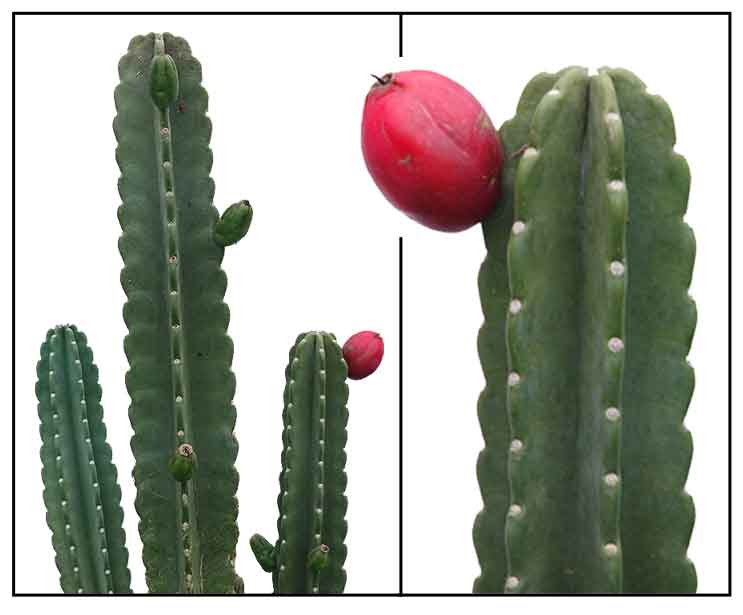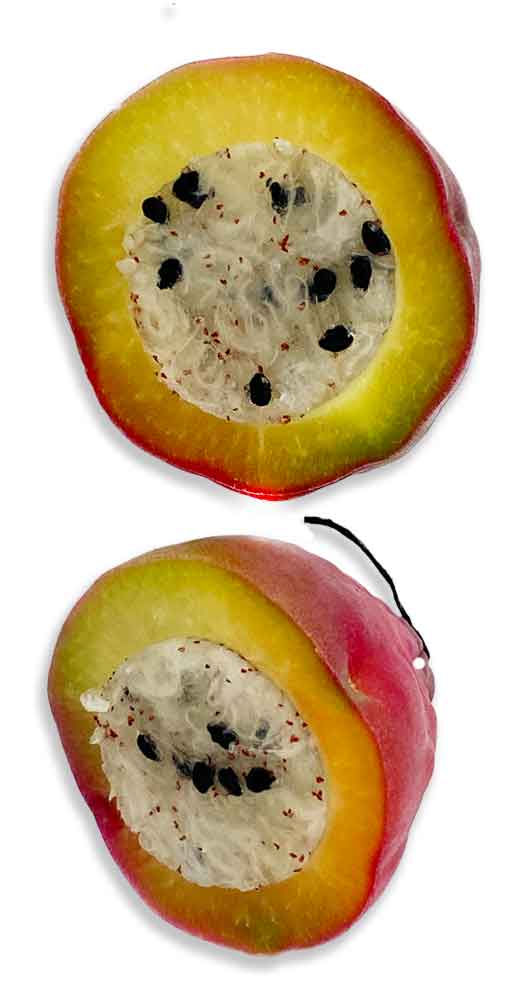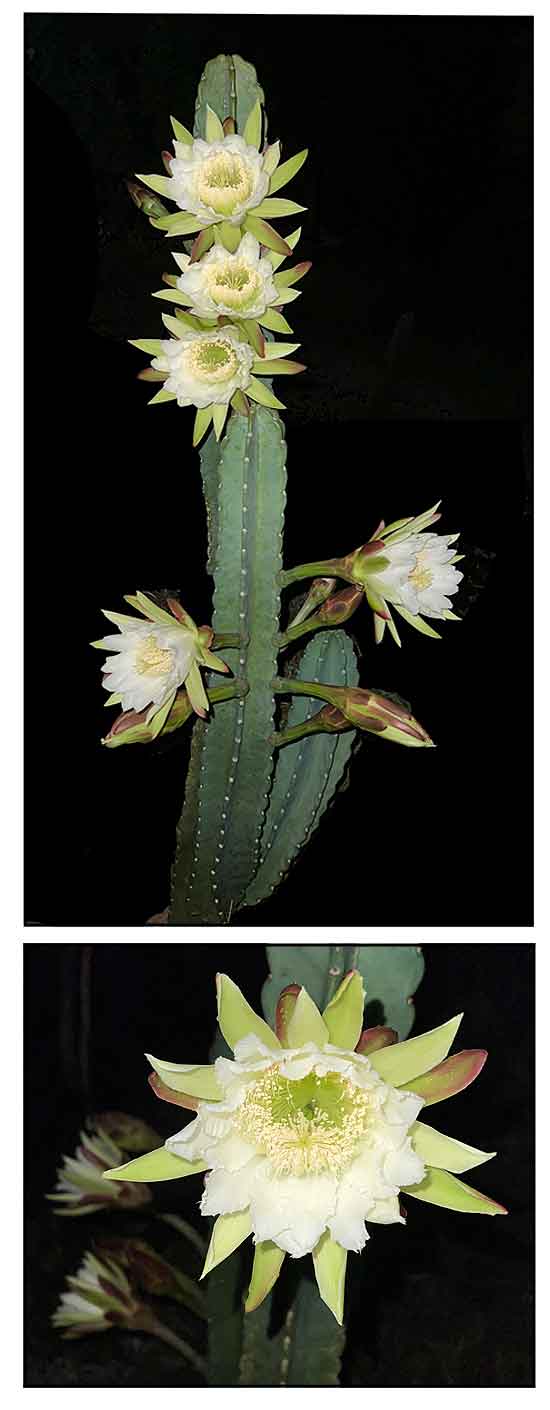  Gen info Gen info
- The name 'cereus' originates in a book by Tabernaemontanus published 1625 and refers to the candle-like form of Cereus hexagonus. and now includes all known cacti with very elongated bodies.
- The genus name "Cereus" derives from Latin, meaning "wax" or "thorn." The specific epithet "repandus" derives from Latin, meaning "spread out or flattened back" referring to the slightly unneven and eaved ribs.
- It is being
touted as an alternative to the gangling and mangy dragon fruit tree. Peruvian apple has the same taste and consistency as the dragon fruit.
- A commercial breeding program in Israel named the plant "Koubo."
Botany
• Cereus repandus is a large shrubby or tree-like cactus with many columnar stems, reaching a height of 10 m. usually much branched from the base. With scaffolding support, it can grow to a height of 34 m. Stems are gray-green to blue-green, cylindrical with 8-13 ribs, sometimes segmented, and up to 20 cm in diameter. Thorns are variable, numerous, gray, and needle-like, but occasionally missing. Longest thorn up to 5 cm long. Flowers are large, white or cream-colored with reddish tips, up to 15 cm in diameter, borne on an elongated tube, somewhat fragrant, tube short and often ridged, stigma exerted before flower open, and nocturnal, which only open for one night. Fruits are without thorns, spherical or egg-shaped, up to 4 cm long, varying in color from dark red, purple, or yellow, containing small, edible, crunchy seeds, the flesh sweetens as it ripens.
• The large-sized flower (~16 cm diameter) opens almost exclusively at night, between sunset and sunrise, as a 24 h rhythm during a specific 3-4 dat span of the lunar cycle (full moon, with a strong correlation between moon phase and number and proportion of flowers in bloom. (11)
Distribution
- Recently introduced.
- Ornamental cultivation.
- Native to Aruba, Columbia, Netherlands Antilles, Venezuela, Venezuelan Antilles, Windward Is. (1)
 Constituents Constituents
- Aqueous extract from callus culture yielded carbohydrate and protein contents estimated at 53.4% and 0.66%, respectively, composed primarily of arabinose and galacturonic acid, with minor amounts of glucose. (see study below) (4)
- Phytochemical screening of dried stem powder yielded alkaloids, carbohydrates, saponins, glycosides, quinones, and coumarins with absence of phenols, flavonoids, proteins, terpenoids, phytosterols.
(6)
- Study of cell cultures yielded high amounts of unsaturated fatty acids, such as w-3, w-6, eicosapentaenoic acid, and docosahexaenoic acid.
(see study below) (8)
Properties
- Attracts bees and butterflies.
- Studies have suggested anti-obesity, anti-ulcer, antiproliferative, antioxidant properties.
Parts used
Flesh, callus.
Uses
Edibility
- Fruits and stems are edible. Fruit is eaten fresh, the flesh with a mild and sweet flavor. Also used in beverages.
- In Aruba and Cura Vao, the green flesh is dried, powdered, or freshly eaten in a mucilaginous soup (cadada in Aruba). It is also cooked with bits of salted pork, goat meat, fish, sweet red pepper and tomatoes.
Folkloric
- No reported folkloric medicinal use in the Philippines.
- The green layer of flesh, found between the cuticle and yellow-colored firm layer of the shoot, is sliced off, sun or fire dried, and consumed to treat diarrhea.
- In the Goalpara District in N.E. India, used for the treatment of cough: Fleshy leaf is roasted over fire, the withered leaves than squeezed and the greenish juice expressed. Juice taken with honey, a teaspoon twice daily for 3-4 days. (9)
Others
- Inner cane-like wood used in wattle and daub construction.
- Agroforestry: Used as cactus fences.
- Fodder: Has good potential as food and feed in arid zones.
- Washing: Slice of cactus used as soap to wash dishes or one's body.
Studies
• Antiulcer / Callus Culture: Study evaluated an aqueous extract from Cereus peruvianus callus culture for anti-ulcerogenic activity in in-vivo models of experimental ulcers in Wistar rats. Results showed the culture to be significantly effective against ethanol-induced lesions but ineffective against indomethacin-induced ulcers. (4)
• Anti-Obesity: Study evaluated the effectiveness of a phytotherapic compound developed from Cereus peruvianus as an adjuvant treatment of obesity in rats fed with a high-fat diet. Sibutramine was used as positive control. The phytotherapic compound, KOUBO, was administered orally at 8 mg/jg twice daily for 30 days. Results showed the phytotherapic compound was effective in decreasing body weight in both male and female rats, with a similar profile to that of sibutramine. (5)
• Antiproliferative Activity / Lipid Profile: Study a fatty acid profile in a callus culture of C. peruvianus. GC and H and C nuclear magnetic resonance spectroscopy showed cells cultures contain high amounts of unsaturated fatty acids, such as w-3, w-6, eicosapentaenoic acid, and docosahexaenoic acid. Biologic assays evaluating for potential antitumor activity used sulforhodamine B method observed 50% cytotoxic concentration of 250 µg/ml. Results contribute to the lipid profile and antitumor activity of callus cultures of C. peruvianus. (8)
• Phenolic Compounds / Antioxidant / Cladode: Study evaluated the total phenolic compounds and antioxidant activity of cladode extracts from C. peruvianus grown in southern Brazil. The profile of phenolic compounds identified five flavonoids not previously reported in the species of the genus Cereus. Total phenolic compounds may vary according to climate and weather conditions. Results suggest the phenolic compounds in the cladode extract has potential as human food and source of natural antioxidants. (10)
Availability
Wild-crafted.
Seeds and plants in the cybermarket.
|

![]()




 Gen info
Gen info Constituents
Constituents